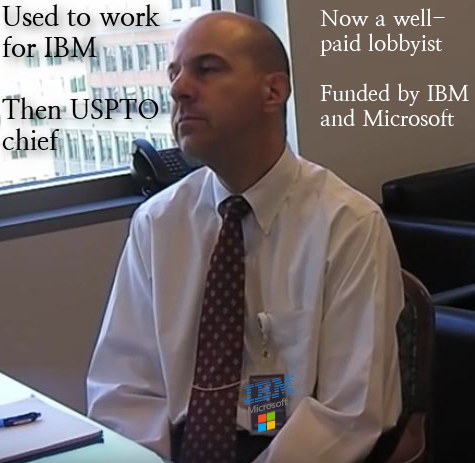

Source: David Kappos interview with Intellectual Property Magazine (2010), modified by us
THE USPTO has a longstanding patent quality problem, albeit with Alice and few other top-level decisions (Mayo for instance) things are improving somewhat.
Motorists could soon unlock the doors of their car simply by walking up to it and taking a selfie.
Jaguar Land Rover is developing technology that uses facial recognition and gait analysis to detect when owners of its vehicles approach, to open the doors for them.
Details have been revealed in a recently published patent application by Jaguar Land Rover, but it is unclear when the technology might become available.
"Nothing innovative here and also it's about software."Let's face it, David Kappos has made more of a farce out of this system, having worked for IBM, a big proponent of software patents. Is the leadership of the USPTO 'on loan' (to large corporations)? Kappos now works as a software patents lobbyist and IBM is one of his clients. It disgraces the whole patent office on ethical grounds and nobody seems to mind.
Looking at some scholarly figures from Patently-O (published this past week, probably for some paper of his), it seems evident that Kappos did a lot of damage to patent quality. As Patently-O put it: "You’ll note the discontinuous nature of the average-PTA chart. The break-point in early 2010 shows the impact of the Federal Circuit’s Wyeth decision holding that the PTO had been under-calculating the adjustment."
That's also the Kappos impact. Here is another new graph. This graph, in our assessment, may simply mean that patent law firms broaden their applications' "template" (notably with citations) in order to patent some more junk and make it seem credible, well-researched. To quote: "The number of references cited per patent continues to rise, albeit more slowly in recent years. For patents issued in 2016, the average patent includes more than 50 cited references. In my view – this is great, although it would certainly help if the examiner was given some clue as to why the reference is deemed relevant or what portion of the reference is relevant. (If an examiner has a question, they can ask the applicant). A not-surprising facet of the growth in references-cited is that almost all of the growth is in applicant-cited. Compared with 10 years ago, applicants cite 26 more references per patent (on average) while examiners cite only 1.5 more per patent. As you might also note from the difference between median and average – the citation distribution is highly skewed. Example: If we take the top-5% of patents from 2016 (those with the most references cited) – they include 35% of all of the cited references. My experience with this skew is that patent applicants considered more valuable by their owners are more likely to submit more prior art references."
"Let's face it, David Kappos has made more of a farce out of this system, having worked for IBM, a big proponent of software patents."There is another new graph at Patently-O and the way we interpret it is quite simple: Quality of patents at the USPTO (or complexity of patents) is declining. Patent examiners don't seem to mind. The more, the merrier.
One last post from Patently-O alludes to Donald Trump and notes that the majority of patents in the US are not even from the US. The part about ITC (where the I should stand for US, not "international") says: "In an email, Prof. Mark Lemley suggests that we should look for “a rise in the importance of the ITC as we focus on blocking imports.” The ITC’s primary goal is to protect U.S. industries against unfair international trade. Lemley writes: “One interesting question is whether Trump will move the ITC’s jurisdiction back to its roots by insisting on a real domestic industry requirement.” Additional ITC movement could push-back against U.S. patents that are owned by foreign nations or unduly subsidized by a foreign nation."
"He'll turn the USPTO into a Great Swamp Again."We criticised the ITC many times. It's just an apparatus of US protectionism, so the I in the acronym is not suitable, like the W in WTO. Another article about Trump's impact, this time from MIP, says: "A panel on the US election at the IP Dealmakers Forum speculated that the Trump administration may take a long time to appoint a USPTO director and the Republican leadership that worked on patent bills in the previous Congress will again push for reform" (we already noted that USPTO Director Lee may be on her way out).
We expect Trump to make the US patent system even worse, as corporate interests tend to be prioritised over people, based on his recent appointments. He'll turn the USPTO into a Great Swamp Again. As for SCOTUS, expect more Conservative Justices there (not just a Scalia replacement), complete with preference for large corporations like Trump's. ⬆
__________
* According to this new placement in IAM, the "USPTO seeks public comment regarding subject-matter eligibility" (covered here before). To quote: "On October 17 2016 the US Patent and Trademark Office (USPTO) announced that two roundtables will be held in the coming months to discuss patentable subject matter eligibility under 35 USC €§ 101. The roundtables have been set up to facilitate public comment and discussion regarding the USPTO’s current guidance on subject-matter eligibility as well as case law arising from interpretation of the requirements under 35 USC €§ 101."